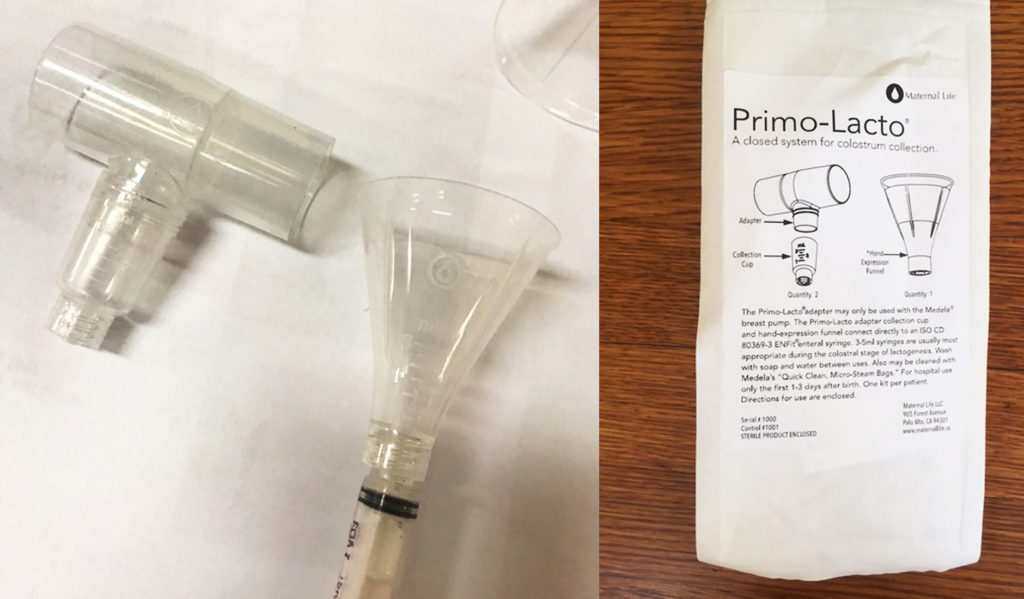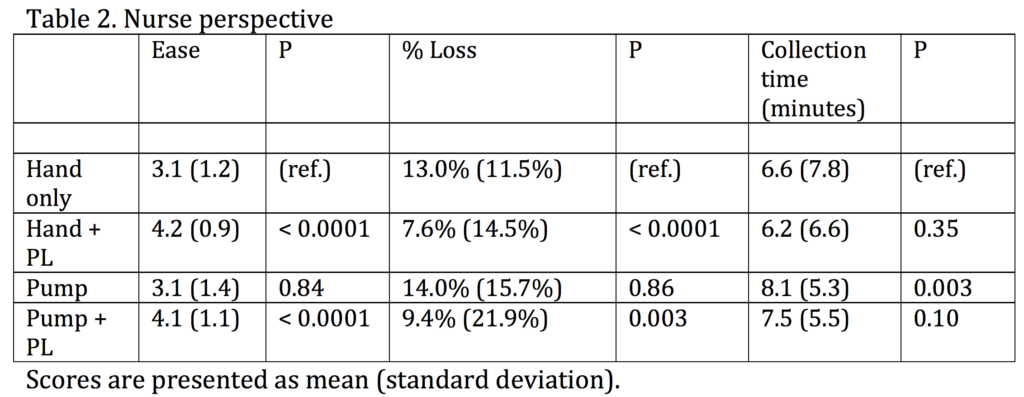
Primo-Lacto uses the new ENFit connector
Maternal Life LLC, my company, has recently completed a clinical pilot study on Primo-Lacto at three different hospitals: Sharp Mary Birch in San Diego, CA, John Muir Hospital in Walnut Creek, CA, and Indiana Memorial Hospital in South Bend, IN.
Primo-Lacto Study Results (With P-values)
Jules Sherman, MFA, Dr. Henry Lee MD, Neonatologist LPCH, Dr. Nancy Wight MD, Neonatologist Sharp Mary Birch Hospital
67 mothers enrolled.
Maternal age median was 29 years old with interquartile range of 21 to 40, total range 17 to 43 weeks. The median gestational age was 32 weeks with interquartile range 26 to 37, total range from 25 to 38 weeks. Median birthweight was 1535 grams, interquartile range 800 to 2850 grams, total range 590 to 4450 grams.
Of 59 with known parity, 61% were primiparous and 39% were multiparous.
The possible score ranged from 1 to 5 with 5 being better (i.e. “Very Easy”, “Very Satisfied”, “Completely Confident”) and 1 being the least desirable (i.e. “Very Difficult”, “Very Dissatisfied”, “Not Confident at All”).Scores are presented as mean (standard deviation).
P-values are based on Wilcoxon signed rank test with “Hand only” as the reference for comparison.
The main result is that ease and confidence were better with Primo-Lacto® for both hand and pump.
For the nurse perspective analysis, there were 89 observations. There were more nurse perspectives than patients as some patients had 2 nurses who participated.
For “Ease,” the possible score ranged from 1 to 5 with 5 being “Very Easy” and 1 being “Very Difficult.”
P-values are based on Wilcoxon signed rank test with “Hand only” as the reference for comparison.
The main results are that ease was better and % lost was less with Primo-Lacto® for both hand and pump. The collection times were not significantly different.
Comments from LCs at Sharp Mary Birch Hospital:
Marilyn Garner BSN, RN, IBCLC, Advanced Clinician, Lactation, Sharp Mary Birch Hospital for Women & Newborns
Karen Voogd, BSN, RN, IBCLC, Lactation Consultant NICU, Sharp Mary Birch Hospital for Women & Newborns
Lenore Morlock, BS, RN, IBCLC, Advanced Clinician, Lactation, Sharp Mary Birch Hospital for Women & Newborns
I would say the results are consistent with the patient’s satisfaction and use of tools, there was a problem with the slip fit syringe falling off and a need to secure the syringe tighter. I can see the new screw-in syringes (ENFit) are a good solution to the problem.
-Marilyn
From Karen Voogd:
Patients seemed to like the funnel for hand expression. Both the funnel and the attachment were greatly improved with the revised product that allows the patient to screw the attachment and syringe, making it more stable and less likely to come apart during use. This system is a wonderful tool for collecting colostrum!
-Karen
From Lenore Morlock:
The equipment was simple to assemble and use, from my standpoint, and also according to feedback received from moms. Several features made colostrum collection much easier, more efficient, and with little wasting of colostrum. The “V” shaped collection funnel, manufactured with materials which reduced friction really helped in the collection of the initial thick viscosity drops. The moms also really liked having the syringe attached directly to the collection funnels. I find this to be even more of a benefit, given that we are now required to use luer lock syringes, which make it impossible to collect all of the colostrum, without having the syringe directly attached to the funnel. (For example, it is not possible to draw all of the colostrum into the luer lock syringe from a medicine cup due to the design of the syringe tip.)
The one difficulty that the patients and I encountered was that the connection between the collection devices and syringe was too loose, causing the syringe to become inadvertently dislodged, resulting in wasting of the colostrum collected. This caused much distress. However, it is my understanding that this problem has been addressed.
Overall, the Primo Lacto equipment was very well received by patients and I felt that this system made my job easier as well. It would be beneficial, I believe, to have this equipment available to use for patients who have, as part of their lactation plan, the expression and collection of colostrum. Thank you for allowing me to participate in this study and evaluation.
-Lenore Morlock
Colostrum is hard to capture because typically the volume is too little initially (a couple drops) and it does not flow easily due to its sticky consistency. Because of this, the favorite tool is the funnel with the syringe attached. The collection from the flange was less successful. Many consultants expressed a desire for the funnel to have more of a steep pitch to the “V” angle to help the colostrum to flow better and to have the funnel itself be as small as reasonably possible so the travel distance to the syringe is as short as possible. The smooth surface of the inside of the funnel is also critical to encouraging the flow of the colostrum.
Additionally, one comment about cost: Costs of supplies have increased and reimbursement has declined. Because of this, we must limit the use of the Primo Lacto to our population of babies 35 weeks and under. All of us would like to use this on all mothers who would benefit. With that in mind, the small funnel with syringe connected sold as one unit would be better for us with the most reasonable cost possible.
Thank you so much for your hard work and creativity in designing and developing and marketing this product. Many mothers are benefitting. We hope to keep this going!
– Mary Ann Jones, Program Manager for Lactation, Sharp Mary Birch Hospital for Women & Newborns


